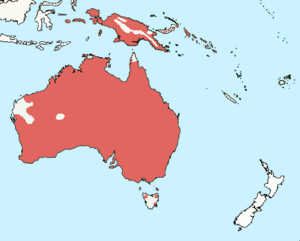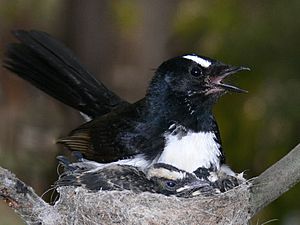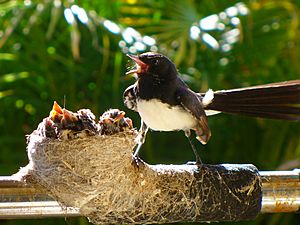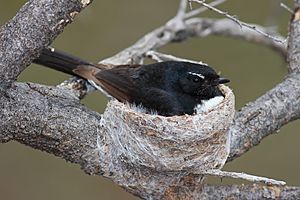Willie wagtail facts for kids
Quick facts for kids Willie wagtail |
|
|---|---|
 |
|
| In the Glen Davis, New South Wales, Australia. | |
| Conservation status | |
| Scientific classification | |
| Genus: |
Rhipidura
|
| Species: |
leucophrys
|
| Subspecies | |
|
R. l. leucophrys |
|
 |
|
| Willie wagtail range | |
The willie wagtail (Rhipidura leucophrys) is a small bird found in Australia, New Guinea, and nearby islands. It's a very common bird that lives in many different places, except for thick forests. This bird is about 19 to 21.5 centimeters (7.5 to 8.5 inches) long. It has striking black upper parts and white underparts. Both male and female willie wagtails look very similar.
There are three types, or subspecies, of the willie wagtail. The Rhipidura leucophrys leucophrys lives in central and southern Australia. The R. l. picata is smaller and found in northern Australia. The R. l. melaleuca is larger and lives in New Guinea and nearby islands. Even though it's called a "wagtail," it's not related to the true wagtails found in other parts of the world. The willie wagtail is part of the fantail family.
Willie wagtails mainly eat insects. They spend a lot of time catching their food in open areas. Their name comes from how they wag their tails from side to side when they are looking for food on the ground. These birds are very brave and will protect their territory. They often chase away much larger birds like the laughing kookaburra and the wedge-tailed eagle. Willie wagtails have adapted well to living near people. You can often see them in city lawns, parks, and gardens. They are also important in Aboriginal stories and beliefs in Australia and New Guinea.
Contents
About the Willie Wagtail's Name
The willie wagtail was first described in 1801 by an English bird expert named John Latham. He gave it the scientific name Turdus leucophrys. The word leucophrys comes from Ancient Greek words meaning "white eyebrow." Early on, some people called it the black-and-white fantail. But the name "willie wagtail" became popular after 1916. The "wagtail" part comes from how it wags its tail. The "willie" part is a bit of a mystery, but it was used for a similar bird on the Isle of Man.
People have given the willie wagtail many other names. Some call it "shepherd's companion" because it follows farm animals. Other names include frogbird, morning bird, and Australian nightingale. Many Aboriginal names for the bird sound like its calls. For example, Djididjidi is a name from the Kimberley region. The Pitjantjatjara people call it tjintir-tjintir(pa). On Bougainville Island, it's called tsiropen. In the Solomon Islands, people sometimes call it the "police bird" or "priest bird" because of its black and white colors.
The willie wagtail is one of 47 types of fantails. Scientists group these birds in different ways. Some put them in the drongo family, while others give them their own family, Rhipiduridae. Studies have shown that fantails are part of a large group of birds, mostly from Australia and nearby areas. This group includes crows and ravens, birds of paradise, and drongos.
Willie Wagtail Subspecies
There are three main types of willie wagtails:
- R. leucophrys leucophrys: This is the most common type found across Australia. All three types look very similar.
- R. leucophrys picata: This type was described in 1848. It lives in northern Australia, from Western Australia to Queensland. It has shorter wings. The name picata means "smeared with pitch" in Latin.
- R. leucophrys melaleuca: This type was described in 1830. It lives in eastern Indonesia, New Guinea, the Solomon Islands, and the Bismarck Archipelago. It is larger than the other types. Its name comes from Ancient Greek words meaning "black" and "white."
What the Willie Wagtail Looks Like
An adult willie wagtail is about 19 to 21.5 centimeters (7.5 to 8.5 inches) long. It weighs about 17 to 24 grams (0.6 to 0.85 ounces). Its tail is about 10 to 11 centimeters (4 inches) long. The bird has a short, thin beak that is about 1.6 to 1.9 centimeters (0.6 to 0.75 inches) long. Its legs are longer than those of other fantails, which helps it hunt on the ground.
Both male and female willie wagtails have similar feathers. Their head, throat, upper chest, wings, upper body, and tail are all black. They have a clear white eyebrow and white "whiskers" on their face, along with white underparts. Their beak and legs are black, and their eyes are dark brown. Young birds may have lighter tips on their wings. Very young birds have duller feathers, with some brown on their upper parts.
Willie Wagtail Sounds
The willie wagtail is a very "chatty" bird and makes many different sounds. Its most common sound is a quick chit-chit-chit-chit, which is an alarm call. It uses this call to warn other birds and its mate about dangers or rivals. It also has more musical calls. One expert said its alarm call sounded like a child's rattle. Another described its pleasant call as sounding like "sweet pretty little creature," often heard day or night, especially on moonlit nights.
Where Willie Wagtails Live
The willie wagtail is common and found in many places. It lives across most of Australia and New Guinea, the Solomon Islands, the Bismarck Archipelago, and eastern Indonesia. Most willie wagtails stay in one area, but some move seasonally. For example, they visit northeastern New South Wales and southeast Queensland in autumn and winter. They are sometimes seen in Tasmania and even on Lord Howe Island.
Willie wagtails can live in many different places, but they avoid thick forests like rainforests. They prefer open woodlands or grasslands with scattered trees, often near water. In New Guinea, they live in clearings made by people, grasslands, and open forests. They have adapted well to human areas. You can often see them hunting in lawns, gardens, parks, and sports fields.
Willie Wagtail Behavior
The willie wagtail is almost always moving during the day. Even when it's resting, it will flick its tail from side to side, looking for food. These birds are usually seen alone or in pairs, but sometimes small groups gather. Unlike other fantails, willie wagtails spend a lot of their time on the ground. When they fly, they beat their wings deeply and often dip quickly. They typically wag their tail when they land after a short flight.
Willie wagtails are very protective of their territory and can be quite brave. They will chase away not only small birds but also much larger ones. This includes the Australian magpie, Australian raven, laughing kookaburra, and even the wedge-tailed eagle. They might even attack pet dogs, cats, and humans if they get too close to their nest. When chasing an opponent, the willie wagtail aims for the back, not the head. Both male and female birds do this, especially during breeding season. A pair of birds will defend their territory by doing a "diving display." One bird stays still while the other loops and dives, and then they switch roles. Both birds sing during this display.
When a willie wagtail is being aggressive, its white eyebrows become wider and more noticeable. When it wants to show it's not a threat, its eyebrows become less visible.
Willie Wagtail Reproduction
Willie wagtails usually stay with the same mate for their whole lives. The breeding season is from July to December. In drier areas, they often breed after it rains. A pair can raise up to four groups of young birds during this time. They build a cup-shaped nest on a tree branch, away from leaves, usually less than 5 meters (16 feet) above the ground. They might also build nests on rafters or under the eaves of buildings. They have been seen building nests near magpie-lark nests, possibly to use the magpie-lark's strong defense against intruders. They are also not afraid to build nests near human homes.
The nest is made of grass stems, strips of bark, and other plant fibers. These materials are held together with spider web. They even use hair from pet dogs and cats! Some have seen them try to take hair from a pet goat. An alpaca farmer saw alpaca wool in willie wagtail nests. The female bird lays two to four small, cream-white eggs with brownish marks. Each egg is about 16 by 21 millimeters (0.6 by 0.8 inches). The female sits on the eggs for 14 days.
Like all passerine birds, the chicks are born naked and helpless with their eyes closed. They stay in the nest. Both parents feed the young birds. They might even start another group of eggs while still feeding the first group. The young birds stay in the nest for about 14 days before they are ready to fly. After leaving the nest, they hide nearby for a day or two before exploring further. The parents stop feeding them after about two weeks, as the young birds start finding their own food. Soon after, the parents chase them out of their territory.
Sometimes, a female pallid cuckoo will lay its eggs in a willie wagtail nest. However, willie wagtails often recognize and remove these foreign eggs, so it's rare for the cuckoo's eggs to hatch successfully. Other cuckoos have also been reported to lay eggs in their nests.
Even though willie wagtails bravely defend their nests, many eggs and young birds are eaten by predators. About two-thirds of eggs hatch, and one-third of the young birds successfully leave the nest. Nestlings can be eaten by pied butcherbirds, black butcherbirds, spangled drongos, and pied currawongs. Feral cats and rats also prey on them. Nests built near people can sometimes be destroyed by children. Male willie wagtails mostly sing at night during the breeding season, especially when the moon is bright.
Willie Wagtail Feeding Habits
The willie wagtail sits on low branches, fences, or posts. From there, it watches for insects and other small creatures in the air or on the ground. It usually catches flying insects like gnats, flies, and small moths. But it will also pick insects off the ground. It often hops along the ground behind people and animals like cows, sheep, or horses. This way, it can catch any creatures that are disturbed by their movement. It wags its tail horizontally while hunting like this. No one knows exactly why it does this, but it might help to scare hidden insects out of the plants, making them easier to catch.
Willie wagtails even pick ticks off the skin of grazing animals like cattle or pigs. They have even been seen taking ticks from lions sleeping in a zoo! They kill their prey by hitting it against a hard surface. Or they hold it and pull off its wings before eating the soft parts inside.
The willie wagtail's ability to adapt and eat many different things has helped it live well near people. It eats a wide variety of arthropods. These include butterflies, moths, flies, beetles, dragonflies, bugs, spiders, centipedes, and millipedes. In New Guinea, they have even been seen killing small lizards like skinks and geckos. Lizard tailbones have been found in their droppings. However, lizards are only a small part of their diet, making up about 1 to 3 percent. Studies suggest that willie wagtails feed larger prey to their young.
Willie Wagtail in Culture
The willie wagtail is an important bird in Australian Aboriginal stories. Some Aboriginal tribes in southeastern Australia believe the willie wagtail brings bad news. They thought the bird could steal secrets by listening around camps. So, women would be careful what they said when the bird was nearby. People in the Kimberley region had a similar belief. They thought the bird would tell the spirit of a dead person if living relatives spoke badly about them. They also saw the willie wagtail as the smartest of all animals.
Its cleverness is also shown in a story from Bougainville Island. In this tale, Singsing Tongereng (Willie Wagtail) wins a flying contest by riding on the back of an eagle. However, the Kunwinjku people in western Arnhem Land saw it as a liar and a tattletale. In a Dreaming story of the Yindjibarndi people, the willie wagtail stole fire and tried to put it out in the sea. It was also believed to send a strong wind if it was scared. In the Noongar language, the willie wagtail is called Djiti-Djiti or Willaring.
The Kalam people of New Guinea highlands call it konmayd. They consider it a good bird. If it came and chattered when a new garden was being made, it meant there would be good crops. They also believe it looks after pigs if it's flying and calling around them. It might also be seen as the ghost of a relative. In New Guinea's eastern highlands, the kuritoro bird was important in a mourning ceremony. A widow would offer banana flowers to her dead husband. If the bird sang nearby, it meant the dead man's soul had accepted the offering.
A story from Bougainville Island says that a maneka, the willie wagtail, darting along a river bank, reminds people of a legendary daughter. She was looking for her mother who drowned trying to cross a flooded river. The willie wagtail has appeared on postage stamps in Palau and the Solomon Islands. It has also been a character in Australian children's books, such as Dot and the Kangaroo (1899) and Blinky Bill Grows Up (1935).
Images for kids
See also
 In Spanish: Abanico lavandera para niños
In Spanish: Abanico lavandera para niños









